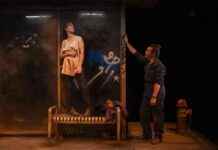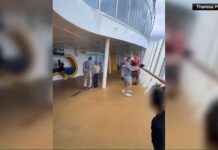It clears on the horizon as Alex points his enthusiasm for the hatch. “Do you want to see dolphins?”. On deck, the wind whips a sail against the mast and, in the water, the whistle of four dolphins pierces the morning. The group of cetaceans dives on the bow of the sailboat for a few minutes until it disappears after a trawler returns to port, in the south of Mallorca. Alex Jonson dismisses them with a look and wields a pair of binoculars to examine infinity. Chase a silent killer.
Alex scours the Mediterranean sea for traces of ghost fishing, drifting nets that become deadly traps for turtles and cetaceans. In Mediterranean waters alone, every year around 150,000 turtles get stuck, according to figures from the World Wide Fund for Nature (WWF, for its acronym in English).
Alex goes with the Va de Bon Coeur, a sailboat handcrafted for 40 years by a Juniper carpenter who sold his house to build his dream and now leaves it to science. The helm is held by another Swiss, Sylvain Liechti, who serves as captain. With the engine off and the sails unfurled, steer the sailboat towards the island and skirt the Emile Baudot escarpment. The sea, which at this time is a pool of oil, hides a rocky wall almost 300 kilometers wide that sinks 2,000 meters deep. The sea currents that go up the slope turn the place into a unique paradise in the Mediterranean for turtles or gray loggerheads, among other species.
Between the Baudot escarpment and the Cabrera National Park, last year Alex glimpsed a turtle tangled in a tangle of raffia. “His two front fins were stuck and we thought he was going to die,” he explains. They named her Love. If the turtle did not die, it was thanks to another fundamental part of the battalion of guardians who defend the marine fauna: the biologist Xisca Pujol, responsible for the turtle recovery center of the Palma Aquarium Foundation.
The epicenter of the Foundation, hidden in the basement of the site, is a heated room that houses five pools the size of a tractor wheel. In all of them there are turtles swimming leisurely in circles. A board with the name, place and date each badly injured animal was found hangs on the wall of each pool. Clad in a striking blue T-shirt, Xisca knows by heart the history of the nearly 25 turtles they host every summer. “He was there for two months and they managed to save one of his front fins.” Half of the specimens return to the sea with an amputated fin. If Amor had lost both fins they would have had to sacrifice him.
For Xisca, there is no doubt that a murderous ghost haunts the Mediterranean. Although they have always cared for turtles damaged by fishing gear, it wasn’t until 2018 that they started treating wounds from raffia tangles and plastic bottles. “It’s a problem that didn’t exist until five years ago.”
Xisca’s story coincides with that of Ricardo, founder of Alnitak, the organization of marine biologists to which Alex Jonson belongs and who has been sailing for 30 years to study marine fauna. Since finding the first one five years ago, they have dismantled more than 600 such artifacts.
The sun marks on Ricardo Sagarminaga’s skin reflect 40 years of experience in the Mediterranean, first with Greenpeace and then with Alnitak. Sitting on deck with a cup of coffee in hand, he looks south to find the root of the problem: “These wads of painted plastic bottles are the typical survival fishing gear they use in North Africa” .
Science proved him right. With the data in hand, Ricardo visited the researchers of the Coastal Observation System of the Balearic Islands (Socib) to compare them with the sea currents and find out the origin of the ghost fishing specimens. The data returned four locations in Algeria and Morocco. “We believe that it is a fishing technique that is used very economically in migrant settlements on the coast of the African continent.”
It’s a rudimentary system made from reused plastic bottles and pieces of raffia that are loosely anchored to the seabed with rope. When it breaks, the current sweeps them out to sea and they become small ecosystems. They cause an oasis effect: algae and small fish arrive first, which attract medium specimens such as tuna. In five weeks, the objects can gather tens of kilos of fish around them. The last to arrive are the larger animals, such as turtles, dolphins or sharks, who, seduced by this whirlwind of life, get caught in the nets.
The remnants of survival fishing are the latest in a larger problem. Before drift longline fishing was regulated, many turtles were found badly injured by the hooks of this technique. It no longer happens on the islands, but it wreaks havoc in the western Mediterranean. In the Alborán Sea, drifting longline nets are a threat and almost 40,000 turtles get caught in such nets every year.
Finding them is difficult, and doing it in time to save his life even more. Despite this, Alex does not give up. He clamps the binoculars back on, stares straight ahead and surveys the big blue mass again. If luck plays a key role in finding a turtle, finding dolphins is even more difficult. When they get stuck, they sink without a trace. Amor the turtle was lucky and after two months in the recovery center was released. “Dolphins like these,” adds Alex as he points to the direction in which they left, “don’t have them.”








